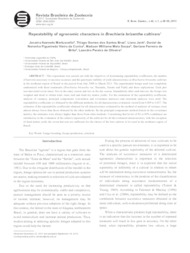Repeatability of agronomic characters in Brachiaria brizantha cultivars.
Repeatability of agronomic characters in Brachiaria brizantha cultivars.
Autoria: MARTUSCELLO, J. A.; BRAZ, T. G. dos S.; JANK, L.; CUNHA, D. de N. F. V. da; SOUZA, M. W. M.; BRITO, G. F. de; OLIVEIRA, L. P. de
Resumo: This experiment was carried out with the objectives of determining repeatability coefficients, the number of harvests necessary to increase accuracy and the genotypic stability of yield characteristics in Brachiaria brizantha cultivars in the northeast region of Brazil in the period from July 2009 to March 2011. The experimental design used was completely randomized with three treatments (Brachiaria brizantha var. Marandu, Xaraés and Piatã) and three replications. Each plot was harvested seven times: five in the rainy season and two in the dry season. Immediately after each harvest, the forage was weighed and dried to obtain total, stem, leaf and dead dry matter yields. For the estimation of the repeatability coefficient, analysis of variance, principal components (correlation and covariance matrices) and structural analyses were used. The repeatability coefficients (r) obtained by the different methods, for all characteristics evaluated, varied from 0.009 to 0.837. The estimates of the repeatability coefficients obtained for all characteristics evaluated by the method of analyses of variance were almost always lower than those obtained by the other methods. By the principal components method (based on the covariance matrix), the estimates were always higher than those from other methods. Considering that levels of 80 or 90% confidence are satisfactory in the evaluation of the relative superiority of the cultivars for all the evaluated characteristics, with the exception of dead matter yield, the seven harvests are sufficient for the choice of the best cultivar to be used in the northeast region of Brazil.
Ano de publicação: 2013
Tipo de publicação: Artigo de periódico
Unidade: Embrapa Gado de Corte
Palavras-chave: Criação forrageira, Forage breeding, Forage production, Forragem, Materia seca, Produção forrageira, Selection, Seleção
Observações
1 - Por padrão são exibidas publicações dos últimos 20 anos. Para encontrar publicações mais antigas, configure o filtro ano de publicação, colocando o ano a partir do qual você deseja encontrar publicações. O filtro está na coluna da esquerda na busca acima.
2 - Para ler algumas publicações da Embrapa (apenas as que estão em formato ePub), é necessário ter, no celular ou computador, um desses softwares gratuitos. Sistemas Android: Google Play Livros; IOS: iBooks; Windows e Linux: software Calibre.
Acesse outras publicações
Acesse a Base de Dados da Pesquisa Agropecuária (BDPA) para consultar o acervo completo das bibliotecas da Embrapa.

